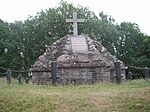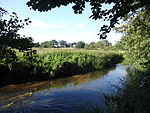Battle of Oeversee
| date | February 6, 1864 |
|---|---|
| place | Oeversee south of Flensburg |
| output | Austrian victory; strategic success of the Danes |
| Parties to the conflict | |
|---|---|
| Commander | |
| Troop strength | |
| a brigade | two brigades |
| losses | |
|
78 dead and 306 wounded officers and men, 47 missing |
18 officers and |
Missunde - Königshügel - Danewerk - Schlei - Oeversee - Jutland - Vejle - Jasmund - Düppeler Schanzen - Fredericia - Helgoland - Alsen - Lundby - North Frisian Islands
The Battle of Oeversee (also the Battle of Sankelmark ) was a skirmish during the German-Danish War of 1864 .
course
The Danish army had already started to withdraw from the Danewerk fortifications during a snowstorm on the evening of February 5, 1864 , which was perceived by the Prussian-Austrian army command as a troop movement. On the morning of February 6, 1864, the Prussian troops under Prince Friedrich Karl of Prussia at Arnis managed , as expected by the Danes, to cross the Schlei and thus bypass the Danewerk position. The Danish commander in chief Christian Julius de Meza then ordered the further retreat in order to avoid encircling his troops.
Hours later, between the villages of Sankelmark and Oeversee , not far from Flensburg , the Austrians from VI, who were allied with the Prussians, met. kk army corps under Feldmarschallleutnant von Gablenz on the enemy. The Danish 7th and 8th Brigade of the 3rd Division of Major General Peter Frederik Steinmann covered the retreat as rearguard and, reinforced by artillery, had entrenched themselves in a favorable defensive position . The Danish 7th Brigade of Lieutenant Colonel Max Müller was able to repel a first attack by the Austrian brigade under Major General Johann Karl von Nostitz with high losses. After reinforcements, including artillery, had arrived for the kk Jäger Battalion No. 9 in action, another frontal attack by the Styrian Infantry Regiment No. 27 "King of the Belgians" followed , which initially got stuck after initial successes. It was only after a successful evasion maneuver that the regimental commander, Colonel Wilhelm von Württemberg , succeeded in repelling the doggedly fighting Danes in a bayonet attack and finally forcing them to withdraw. However, the hesitant resistance of the defenders had meanwhile enabled the majority of the Danish army to withdraw in an orderly manner as planned, so that the battle was a strategic success for the Danes.
During the fight, which lasted only a few hours, the Austrians lost 28 officers and 403 ordinary soldiers, while the Danes, who were caught in heavy artillery fire while fleeing, lost 18 officers and 944 soldiers. The wounded soldiers were cared for in the royal Danish privileged Historisches Krug in Oeversee, the world's first field hospital under the flag of the recently founded Red Cross , which was also the headquarters of the Austrians.
Because the military police battalion mainly involved in combat no. 9 as well as the Imperial and Royal Infantry Regiment. 27 "King of the Belgians" his home garrison in Graz , had there in the city a Oeverseegasse and An in-this alley, 1902 based Oeversee -Gymnasium . Conversely, there is a Grazer Platz in Oeversee . In the 15th district of Vienna there is also an Oeverseestrasse to commemorate this battle . There is a memorial at the site of the battle. Residents of Flensburg , about ten kilometers away , still commemorate the help of their citizens for the wounded the day after the battle in an annual Oeversee march from Flensburg- Martinsberg to Oeversee .
gallery
View of the battlefield with the Treene
literature
- Jan Ganschow, Olaf Haselhorst, Maik without time: The German-Danish War 1864. Prehistory - course - consequences . Graz 2013.
- J. Christensen et al.: 1864. Fra helstat til nationalstat. Fårevejle 1998.
- M. Embree: Bismarck's first was. The campaign of Schleswig and Jutland 1864. Solihull 2007.
Web links
- Battle of Oeversee on schlei-ostsee-urlaub.de
- Slaget ved Sankelmark (Battle of Sankelmark) on graenseforeningen.dk (Danish)
- Rømningen af Dannevirke (clearing of the Danewerk) on milhist.dk (Danish)
Individual evidence
- ^ A b Olaf Haselhorst: The German-Danish War of 1864. In: Jan Ganschow, Olaf Haselhorst, Maik without time (ed.): The German-Danish War 1864. Prehistory - course - consequences. Graz 2013, pp. 87–149, p. 107.
- ↑ Ole Louis Frantzen: De slesvigske krige. Danmarks historie, Danmark 1849-1945. In: The Danske Encyklopædi store . denstoredanske.dk, February 2, 2009, accessed September 1, 2013 (Danish).
- ↑ a b Kjeld Hillingsø: Sankelmark. Danmarks historie Sønderjyllands og Slesvig-Holstens historie. In: The Danske Encyklopædi store . denstoredanske.dk, January 2, 2009, accessed September 1, 2013 (Danish).
- ↑ School History> Chronicle oeversee.at, BG / BRG Oeversee Graz accessed 23 September 2019. - "in July 1903 ended ... the first school year"
Coordinates: 54 ° 43 '2.7 " N , 9 ° 26" 38.2 " E






